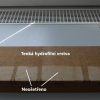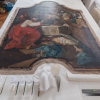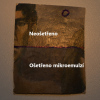Microemulsions and gels for cleaning surfaces of historical materials
Technology description
| The name of the technology: | Microemulsions and gels for cleaning surfaces of historical materials |
|---|---|
| Challenge: | Removing unwanted material from the surface of historical artefacts is one of the most complex operations in the restoration of cultural heritage objects. Cleaning is often used with products that are aggressive towards the material being cleaned and can lead to its irreversible damage. Upon contact, they can damage the health of the user, their preparation is complicated and expensive. During restoration processes, it is essential to remove only the desired material without any damage to other layers and the artifact itself. |
| Description: |
As gentle as possible yet highly effective cleaning microemulsion systems for removing unwanted substances from the surface of historical materials. They gently remove acrylate or vinyl polymers, waxes, oils or unwanted monomeric or polymeric hydrophobizing agents. The shortcomings of the methods used today are eliminated by our newly developed method. It is based on a combination of two functions, basic micellar solutions or microemulsions of non-ionic surfactants, which remain the same for different target surfaces (or substances to be removed from the surface) and specific solvents, which in turn are selected according to the respective material to be removed. The main component here is water, the content of active ingredients is very low, in the range of several percent, which is advantageous in terms of environmental impact, method of production and price. The advantage of this method is that it facilitates the formulation of various cleaning compositions, which translates into easier and more economically advantageous production. Main benefits: • High efficiency when only the target material is removed • Possibility to produce tailor-made cleaning mixtures - can be incorporated into gels • Maximum friendliness to the artifact, to the health of the restorer and to the environment • Easily manufactured from commonly available components without the use of special equipment • Wide range of application methods, e.g. pouring, painting, impregnating or spraying • Certified conservation practice for a new method of surface protection |
| Commercial opportunity: |
• Removal of layers, coatings or surface residues of various materials of historical artifacts (eg stone, wood, metals, oil paintings) • Increasing the efficiency of removing surface layers, with a low impact on the environment • A new method of surface protection of building materials by the method of hydrophobization with a thin surface layer, which ensures sufficient protection with unchanged surface properties. |
| IP protection status: | The principle of the method and specific applications are protected by patents owned by the J. Heyrovsky Institute of Physical Chemistry AS CR v.v.i. in Prague: CZ 305475, CZ 305490, CZ 305526, CZ 305527, CZ 305528. |
| Development status: |
Phase 3Corresponds with TRL 5 and TRL 6 Technology validation and implementing it in real environment. Testing the technology outside of the laboratory and its adjustment to external conditions.
|
| Partnering strategy: | Collaboration licensing |
| More information: | |
| Images: | |
| Categories: | Theoretical and Applied Physics & Chemistry Engineering |
| Owner of a technology: |



